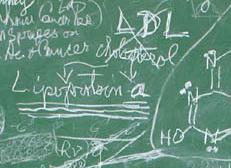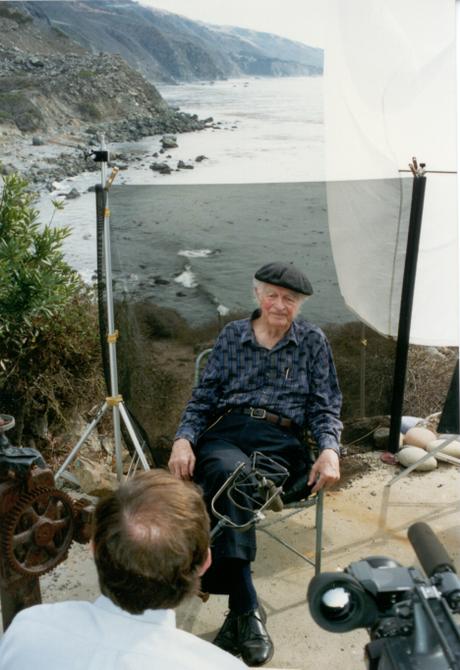
A note on LDL cholesterol and Lipoprotein (a) written by Pauling on his office chalkboard.
[An analysis of Linus Pauling’s research on vitamin C and heart disease, part 4 of 4]
In June 1992, Linus Pauling visited the Texas Heart Institute, after which he accepted an offer to write an editorial for the organization’s journal. He completed his short piece, “Can Vitamins Help Control Heart Disease and Strokes?” in March 1993, a little over a year before he passed away.
The Texas Heart Institute article turned out to be Pauling’s final public statement of consequence on the question of ascorbic acid and cardiovascular health. In his text, he argued once again that, although physicians had long known that arterial lesions cause heart disease, they had not yet accepted the evidence that lesions are brought about by low levels of vitamin C in the blood. This consensus had been maintained despite a widely accepted understanding that vitamin C is necessary to repair bodily tissues via collagen production.
Unfortunately for Pauling, the research required to clearly to shift scientific opinion was not forthcoming. Pauling realized that a major study needed to be funded to show a strong relationship between intake of larger doses of nutritional supplements (especially vitamin C) and even greater preventative or therapeutic health benefits for victims of cardiovascular disease. As the idea’s chief proponent, Pauling would have seemed to be a primary figure in attracting grant funds for such a study. However, in part because of the intense controversy over Pauling’s previous work with vitamin C and the common cold, and vitamin C and cancer, Pauling’s reputation had been badly marred within the medical mainstream, and research dollars had become very difficult for Pauling to source.
Partly as a result, his and Matthias Rath’s work stressing the importance of vitamin C as a key factor in combating heart disease was perhaps a case of too little, too late. Though the tandem had succeeded in establishing a general sense of the potential importance of vitamin C in heart disease prevention, the circumstances surrounding their work were not ripe enough for the duo to develop a more complete and lasting understanding of the types and levels of nutrients needed to ensure optimum heart health.

Linus Pauling giving an interview at Deer Flat Ranch, September 1993.
Other material considerations further compounded the problem. For one, at precisely the same time that the cardiovascular work was gaining traction, the Linus Pauling Institute of Science and Medicine was in the depths of dire financial straits. Furthermore, Linus Pauling was now nearly 93 years old and in declining health. As he battled with the cancer diagnosis that would ultimately claim his life, Pauling realized that could no longer go on assisting Rath. Meanwhile, Rath’s relationship with others in the Institute had fallen into turmoil, and the Linus Pauling Heart Foundation, which Rath directed, was withering on a vine of financial insolvency.
Rath was ultimately asked to leave the Institute amidst a period of legal disarray, partly a result of his having never signed the Institute’s mandatory employee patent agreement. In the wake of his departure from the Institute, and following the death of Linus Pauling in August 1994, the Unified Theory of Human Cardiovascular Disease largely slipped into obscurity, though some echo of it has remained in the public consciousness.
In the years that followed Pauling’s death, the Institute’s cardiovascular program continued to investigate the role that nutrients like vitamin C, E, and B6 might play in limiting oxidative damage brought about by low density lipoproteins (LDL) in individuals suffering from atherosclerosis. Similar work is on-going today in multiple laboratories.
At present, the scientific understanding of the importance of vitamin C in preventing or treating heart disease remains somewhat mixed. Although vitamin C does not appear to directly lower blood cholesterol levels, evidence exists that it does significantly lower low density lipoprotein and Lp (a) levels, which in turn helps to protect arteries from blockage by these cholesterol-carrying molecules.
Total blood cholesterol may also lessen with increased vitamin C intake due to the fact that vitamin C is an HMG-CoA reductase inhibitor, meaning that if vitamin C levels are high, the body manufactures less cholesterol. Additionally, vitamin C’s benefits to the body as both a primary collagen producer and as an antioxidant contribute to what most studies agree to be a significant, though still not fully understood, protective effect against heart disease when taken in doses of 400 to 2,000 mg daily. As in Pauling’s era, this level of supplementation is far above the current Recommended Daily Allowance for adult men and women, which is 60 mg per day.
Likewise, the interaction between lysine and vitamin C that many of Pauling’s case study patients found to be highly therapeutic – with anecdotal reports of actual reversal of atherosclerosis in certain patients – has not been investigated further. And so it is that, more than twenty years after his death, Linus Pauling’s ideas on the impact that nutritional supplementation might make on heart health remain just as tantalizing and out of reach as they were when Pauling was alive and active.
Advertisements